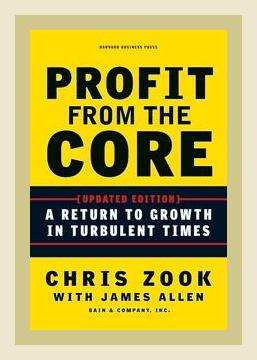Business StrategyCompetitive Strategy
Introduction
“Profit from the Core” by Chris Zook focuses on the idea that companies should achieve growth by leveraging their core business rather than veering off into risky and often unsuccessful diversification. Zook argues that understanding and capitalizing on the core business can lead to sustainable and profitable growth, especially in turbulent times. Drawing on extensive research and examples, the book offers actionable insights and strategies.
Chapter 1: Understanding the Core
Key Point: Knowing Your Core Business
Zook defines the core as the intersection of a company’s most profitable products, customers, and capabilities. A deep understanding of the core is essential for directing resources and efforts.
Actionable Step: Conduct a Core Analysis
- Example: The book discusses Sears, which lost its way by diversifying too broadly and neglecting its core competencies in retail.
Action: Conduct a thorough assessment of your core competencies. Use tools like SWOT analysis to determine your strengths, weaknesses, opportunities, and threats within your core business.
Chapter 2: The Paradox of Growth
Key Point: The Growth Paradox
Many companies struggle because growth initiatives are often too far from their core. Zook emphasizes the need to expand within the realm of the core.
Actionable Step: Focus on Adjacent Markets
- Example: PepsiCo expanded successfully by venturing into snacks, leveraging its distribution channels, marketing expertise, and brand recognition.
Action: Identify and explore adjacent markets where your current strengths will give you a competitive edge. Chart out opportunities that are directly related to your core offerings.
Chapter 3: The Economics of Core
Key Point: Economic Discipline
The economy of scale and focused investments are beneficial when staying close to the core.
Actionable Step: Apply Economic Analysis
- Example: Gillette succeeded by focusing on razor blades, where it applied specialized knowledge to maintain a significant market share.
Action: Conduct a rigorous financial analysis to ensure that your growth opportunities make economic sense and contribute positively to the bottom line.
Chapter 4: Mastering Customer and Competitor Insights
Key Point: Deep Customer Insights
Understanding customer needs and competitor moves allows for better alignment of your core business.
Actionable Step: Invest in Market Research
- Example: Harley-Davidson engaged deeply with its customer base, adjusting its offerings and enhancing brand loyalty.
Action: Regularly gather data on customer preferences and competitor strategies. Use this information to fine-tune your products and services.
Chapter 5: New Growth Platforms
Key Point: Building New Growth Platforms
Zook examines how companies should build new growth platforms by leveraging their core strengths rather than diversifying too far afield.
Actionable Step: Innovate Within Boundaries
- Example: Nike built new growth platforms by extending its brand into apparel and equipment, leveraging its core strengths in brand management and design.
Action: Identify growth platforms that are natural extensions of your core business. Innovate in areas where your current capabilities can be maximally utilized.
Chapter 6: Organizational Focus
Key Point: Organizational Alignment
Aligning the entire organization to the core business is crucial for executing growth strategies effectively.
Actionable Step: Align Goals and Incentives
- Example: Dell successfully focused its organizational efforts on direct sales and mass customization, aligning every part of the business with its core value proposition.
Action: Ensure that every department and employee understands and works towards the core business goals. Align performance incentives with core business achievements.
Chapter 7: The Core Renewal Framework
Key Point: Framework for Renewal
Zook provides a structured framework for constantly renewing and adapting the core business in response to market changes.
Actionable Step: Implement Iterative Frameworks
- Example: Procter & Gamble used a constant renewal framework to stay relevant, refreshing its product lines while staying true to core strengths in consumer goods.
Action: Develop a continual improvement process that regularly assesses and updates the core business strategies to adapt to changing market conditions.
Chapter 8: Leadership and Culture
Key Point: Leadership Driving Core Growth
Leaders play a crucial role in prioritizing and sustaining core-focused growth.
Actionable Step: Foster a Core-Centric Culture
- Example: Southwest Airlines’ leadership consistently emphasized operational efficiency and customer service, keeping the company focused on its core strengths.
Action: Cultivate a leadership team that values the core business principles and imbues the organizational culture with a focus on the core mission. Encourage leaders to make decisions that favor core growth.
Chapter 9: Signposts of Turbulence
Key Point: Recognizing and Responding to Turbulence
Understanding the signs of market turbulence and responding appropriately can help maintain focus and growth.
Actionable Step: Set Up Early Warning Systems
- Example: IBM successfully transitioned through different market turbulences by recognizing early signs and pivoting while staying close to its core technological expertise.
Action: Establish mechanisms for early detection of market shifts, such as regular market analysis and predictive analytics. Have contingency plans ready to respond to these signals.
Chapter 10: Strategic Simplicity
Key Point: Keeping Strategies Simple
Complex strategies often fail. Simplicity and clarity in strategy are essential for successful execution.
Actionable Step: Simplify Strategic Focus
- Example: McDonald’s turnaround strategy in the early 2000s involved simplifying its menu and focusing on core products, which led to renewed growth.
Action: Strip down your strategic initiatives to their core essentials. Ensure that every strategy has clear, manageable steps that align closely with core strengths.
Conclusion
“Profit from the Core” emphasizes that staying true to the essence of what makes a business successful is the key to enduring growth. In turbulent times, companies can thrive by leveraging their core strengths and focusing on strategic simplicity, customer insights, and constant renewal.
By applying these principles, businesses can achieve sustained, profitable growth. For each major strategic insight Zook presents, there is a corresponding action that businesses can take to align themselves with these best practices, ensuring their growth initiatives are both grounded and effective.
